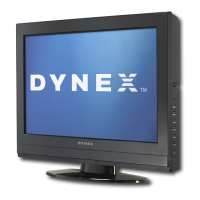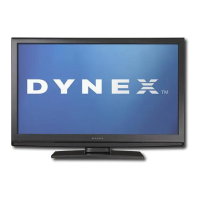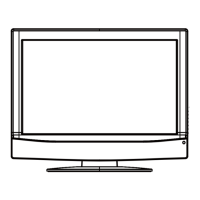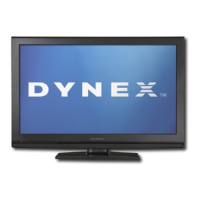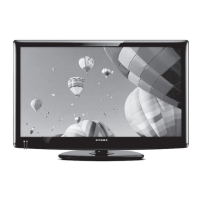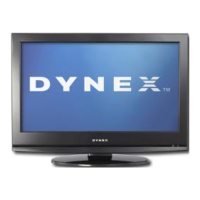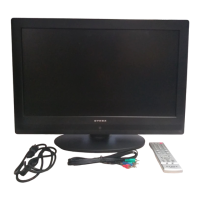What to do if buttons do not work on Dynex DX-L22-10A?
- Eelizabeth12Jul 31, 2025
If the buttons on your Dynex LCD TV aren't working, try unplugging the power cord for a few seconds, and then plug it back in and turn the TV on.
What to do if buttons do not work on Dynex DX-L22-10A?
If the buttons on your Dynex LCD TV aren't working, try unplugging the power cord for a few seconds, and then plug it back in and turn the TV on.
How to reset password on Dynex DX-L22-10A LCD TV?
To reset a lost password on your Dynex LCD TV, go to the Parental Controls menu and enter '9999' as the password. This will allow you to set a new password. See “Setting parental controls” on page 20 for more information.
Why can't Dynex DX-L22-10A LCD TV tune to certain channels?
If you cannot tune to certain channels on your Dynex LCD TV, it could be due to parental controls blocking the program. Check “Setting parental control levels” on page 20 or “Turning parental controls on or off” on page 18 for details. Alternatively, the channel might have been removed from the channel list. You can tune to it directly using the number buttons or add it back to the list. See “Changing channel settings” on page 15 for instructions.
Why does Dynex DX-L22-10A LCD TV cabinet creak?
The creaking noise from your Dynex LCD TV cabinet is normal. It happens because the temperature inside the cabinet increases when the TV is on, causing the material to expand or contract.
Safety tips for TV placement and usage, focusing on preventing tip-overs and ensuring stability.
Guidelines and precautions for mounting the TV on a wall, including selecting appropriate mounts.
Covers electrical shock hazards, lightning protection, and power line safety for the device.
Precautions for care and potential damage to the screen, including liquid contact.
Guidelines for using correct manufacturer-specified replacement parts to avoid hazards.
Procedures for ensuring safe operation after any service or repair.
Information on operating the TV from the correct type of power source.
Notes on damage requiring service and warnings about incorrect adjustments.
Step-by-step guide to attaching the TV stand for upright placement.
How to tilt the TV forward or backward for optimal viewing.
Instructions for safely detaching the TV stand from the unit.
Steps for attaching a wall mount bracket to the back of the TV.
Identifies and describes components located on the front panel of the TV.
Identifies and describes components and ports on the back panel of the TV.
Identifies and describes components located on the side panel of the TV.
Overview of the remote control's buttons and functions.
A guide for properly inserting batteries into the remote control.
Tips for effective remote control operation and sensor alignment.
Instructions for setting up universal remote controls to operate the TV.
How to connect the TV to a standard AC power outlet.
Guide for connecting television signal sources via RF cable.
Steps to connect a VCR to the TV using AV or S-Video cables.
Instructions for connecting camcorders or game consoles via AV cables.
How to connect devices using an HDMI cable for high-quality video and audio.
Steps for connecting component video sources for improved picture quality.
Guide for connecting a PC to the TV using VGA and audio cables.
How to connect headphones to the TV for private audio listening.
Basic operation for powering the TV on and off, including standby mode.
How to choose and switch between different connected video sources.
An introduction to the TV's main on-screen menu structure.
How to use the remote control buttons to navigate the TV's menu system.
Methods for changing TV channels, including direct number entry and lists.
How to control the TV's sound level using the remote or TV buttons.
Overview of fundamental picture and sound adjustments available.
Detailed guide to adjusting picture settings like contrast, brightness, and color.
Specific settings for optimizing the picture when a computer is connected.
Guide to selecting sound modes, adjusting bass, treble, and balance.
How to choose audio output modes for analog channels (Mono, Stereo, SAP).
Feature to disable the TV picture and listen to audio only.
Process for automatically scanning and tuning available channels.
How to choose the input source (Air/Cable) for channel tuning.
Method to skip specific channels in the channel list when browsing.
Creating a personal list of preferred channels for quick access.
Customizing channel names for easier identification in lists.
Enabling or disabling content restriction features using a password.
Managing the password used for accessing parental control settings.
Configuring rating-based content blocking for TV and movie content.
Obtaining program rating data to assist with setting content restrictions.
Enabling or disabling subtitle display for programs.
Choosing different captioning display modes or styles.
Adjusting font, size, and appearance of closed captions for digital TV.
How to set the TV's internal clock, including time zone and DST.
Configuring the TV to automatically turn off after a specified period.
Changing display language and background opacity of on-screen menus.
Assigning custom names or labels to TV input ports for easier identification.
Resetting TV configurations to factory default values.
Solutions for common problems related to picture and sound.
Troubleshooting steps for a non-responsive remote control.
Solutions for general issues not covered in specific categories.
